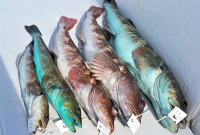Support strong Canadian climate journalism for 2025
Fish have plenty to say and we need to make more of an effort to listen to them and understand what they’re talking about, researchers say.
The hums, grunts, squeals and even farts made by soniferous, or noise-making, fish are a noteworthy part of the ocean soundscape, said marine ecologist Kieran Cox.
The former University of Victoria researcher was part of an international team that combed through more than 800 studies to catalogue vocal species and created a publicly accessible global library called FishSounds.
Though fish are the largest and most diverse group of sound-producing vertebrates in the water, there hadn’t been a comprehensive inventory to identify which species make noise or the particular sounds they produce, said Cox.
“This was one of the major questions that needed to be addressed: How many fish make noise?” Cox said.
The research team identified nearly 1,000 species of fish that produce sound, and there are likely more, Cox said, adding new research or recordings that surface on different fish can be added to the FishSounds online database.
Fish communication can help conservation
Recognizing which fish make sounds and why is useful to help measure the impacts of human-caused noise pollution in the marine environment, Cox said.
Noise pollution — largely the result of a dramatic rise in shipping, which doubled between 1950 and the end of the century, and compounded by seismic blasting for oil and gas exploration and the use of military and commercial sonar — is understood to have short- and long-term impacts on marine animals, such as fish, whales and water mammals that use sound to communicate, navigate, feed and reproduce.
Excessive noise pollution can stress fish or potentially interfere with a soniferous fish’s ability to communicate, find a mate, locate food or evade predators, Cox said.
“Humans are changing aquatic soundscapes. We're introducing huge amounts of noise pollution,” he said, adding his future research will examine noise pollution in B.C.’s rockfish conservation areas.
“We’re changing the conditions that these fishes live in and we need to understand how they're using that soundscape and contributing to it to conserve aquatic systems.”
Eavesdropping on fish with non-invasive equipment such as hydrophones can also help conservation efforts by identifying which species might be flourishing in marine protected areas, or as an early warning signal to track invasive species, Cox said.
Varied scale of fish sounds
Fish can produce a variety of sounds by rubbing or striking bony parts of their body, or by vibrating their swim bladder to make drumming sounds.
Some fish, like Pacific herring, even communicate by farting, Cox said.
“It’s probably one of the weirdest sounds, and one people gravitate towards because it’s quite funny,” he said.






Comments